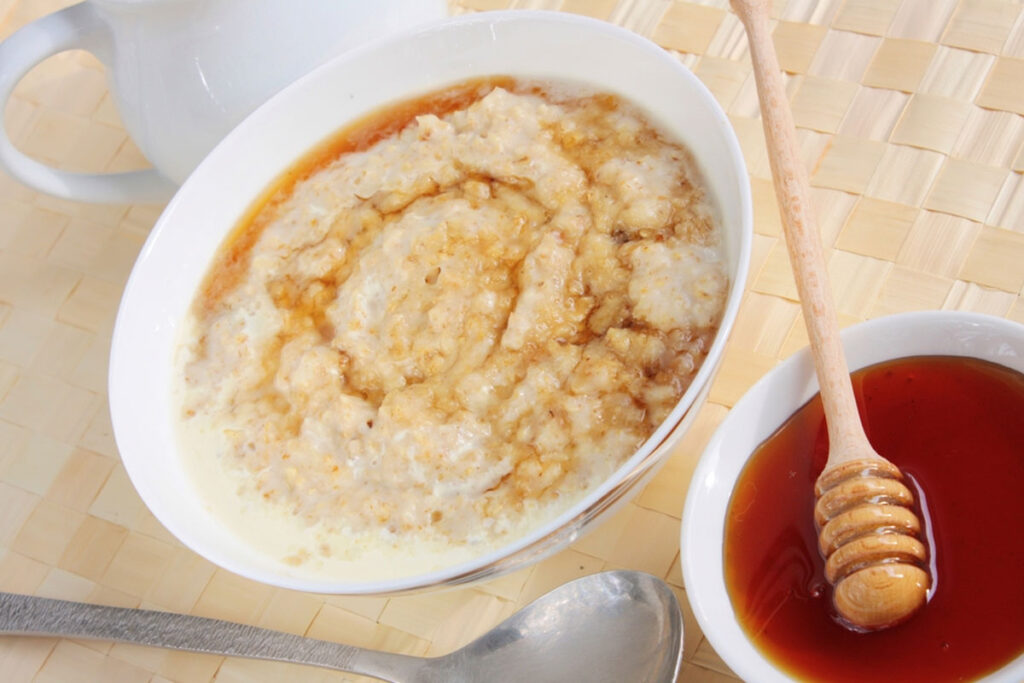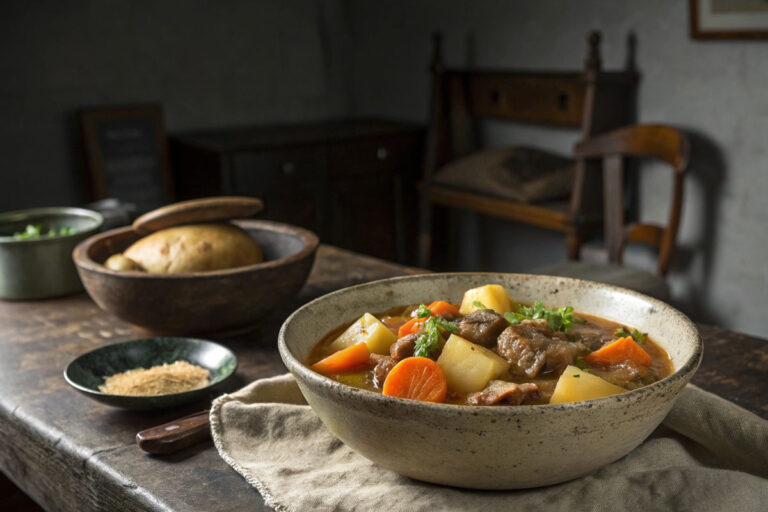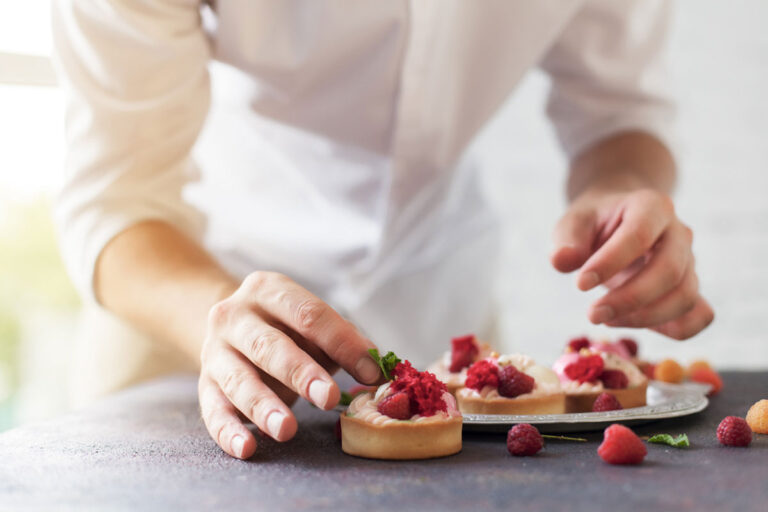The Origins and Legacy of Irish Porridge
Irish porridge, a humble yet deeply cherished breakfast dish, has been an integral part of the Irish diet for centuries. Its roots stretch back to ancient times when oats, one of the few grains that thrived in Ireland’s cool and damp climate, became a staple food for the island’s population. Unlike wheat, which struggled in Irish soil, oats were resilient and provided a vital source of nourishment for both the rich and poor.
Historically, porridge was made from stone-ground oats and cooked slowly over an open fire, creating a thick, hearty meal that sustained families through long days of work on farms or in fields. Known as “gruel” in earlier times, it was sometimes eaten with buttermilk or a sprinkle of salt. In poorer households, porridge often served as more than just breakfast—it was eaten at any time of the day, providing essential energy and sustenance.
Throughout the 19th century, porridge remained an important element of Irish food culture, even during the Great Famine. Though potatoes were the primary food source at that time, oats and porridge offered a lifeline for many families who could still grow or access them.
In modern Ireland, porridge has undergone something of a renaissance. While the traditional preparation remains a favorite, it is also celebrated for its versatility, allowing for countless variations in flavor and texture. From its humble beginnings, Irish porridge has evolved into a breakfast that embraces both tradition and innovation.
The Health Benefits of Irish Porridge
Irish porridge isn’t just a beloved traditional dish—it’s also one of the healthiest breakfast options available. The nutritional value of oats has long been recognized, and the slow-cooked porridge that has sustained Irish families for generations offers numerous health benefits.
1. Rich in Fiber
Oats are packed with soluble fiber, particularly beta-glucan, which plays a crucial role in maintaining heart health. This type of fiber helps to lower cholesterol levels, reducing the risk of heart disease. The fiber content also promotes good digestive health by encouraging regular bowel movements and feeding beneficial gut bacteria.
2. Sustained Energy
One of the reasons porridge has been a dietary staple in Ireland is its ability to provide long-lasting energy. The complex carbohydrates in oats release energy slowly, keeping you fuller for longer and preventing the spikes and crashes associated with more processed breakfast options. This sustained energy is especially important for busy mornings or long, active days.
3. Blood Sugar Control
For those managing blood sugar levels, porridge is a smart choice. The slow-release carbohydrates help regulate glucose levels, which can be particularly beneficial for people with type 2 diabetes. The soluble fiber also contributes to stabilizing blood sugar, making porridge a low-glycemic index food that delivers gradual energy without overwhelming the system.
4. High in Antioxidants
Oats are also high in antioxidants, particularly a group known as avenanthramides, which are unique to this grain. These antioxidants have anti-inflammatory properties and have been shown to improve blood flow and lower blood pressure. Including porridge in your daily diet can therefore contribute to overall cardiovascular health.
5. Rich in Vitamins and Minerals
Traditional Irish porridge is a great source of essential vitamins and minerals. It provides iron, zinc, magnesium, and B vitamins, all of which are important for energy production, immune function, and maintaining a healthy metabolism. Whether eaten on its own or topped with fruits and seeds, porridge offers a nutrient-dense start to your day.
Exploring Different Types of Oats
The beauty of traditional Irish porridge lies in its simplicity, yet the variety of oats available today allows for different textures, flavors, and cooking methods. Let’s look at the various types of oats you can use to make porridge, how they differ, and what each type brings to the table.
1. Steel-Cut Oats (Irish Oats)
Steel-cut oats, also known as Irish oats, are the least processed type. The whole oat groat is chopped into two or three pieces, resulting in a hearty texture and a nutty flavor when cooked. Steel-cut oats take longer to cook (usually about 20-30 minutes), but they offer a satisfying chew and a more rustic, wholesome porridge. This is the traditional oat used in Irish porridge, celebrated for its robustness and ability to absorb flavors well.
2. Rolled Oats (Old-Fashioned Oats)
Rolled oats are made by steaming and flattening whole oat groats with large rollers. These oats cook more quickly than steel-cut oats, taking around 5-10 minutes to prepare. Rolled oats yield a creamier, softer texture compared to steel-cut oats, but still maintain some chew. They are a versatile option, ideal for those who prefer a quicker-cooking porridge while still enjoying the nutritional benefits of whole oats.
3. Quick Oats
Quick oats are similar to rolled oats but are processed further, making them thinner and smaller. This allows them to cook very quickly, usually in just a couple of minutes. While convenient, quick oats result in a much softer, more mushy porridge, lacking the texture found in steel-cut or rolled oats. Quick oats are best suited for those who need a fast meal but may sacrifice some flavor and texture.
4. Instant Oats
Instant oats are the most processed version, pre-cooked, dried, and finely chopped for quick preparation. They often come in individual packets, sometimes pre-flavored, and can be ready in a minute with just hot water. While highly convenient, instant oats are usually the least nutritious option due to the added sugars and preservatives found in many flavored varieties. They also create a porridge that is much less hearty, with a thinner consistency.
5. Oat Groats
Oat groats are the whole, unprocessed kernels of the oat grain. They take the longest to cook, often requiring an hour or more, but they produce the most nutrient-dense and chewy porridge. Oat groats offer a truly traditional experience, perfect for slow cooking or overnight preparations. Their nutty flavor and firm texture provide a unique twist on porridge for those looking to try something a bit different.
Each type of oat can contribute to a distinct porridge experience, from the creamy smoothness of quick oats to the hearty chew of steel-cut oats. The choice of oat largely depends on personal preference, time constraints, and how traditional you want your porridge to be.

Classic Irish Porridge Toppings
One of the best things about porridge is its versatility. While traditional Irish porridge is often enjoyed plain or with a splash of cream, a variety of toppings can transform it into a flavorful and nutritious meal. Now we will explore classic Irish porridge toppings, ranging from simple additions to more indulgent options.
1. Cream and Honey
One of the most traditional and beloved combinations in Irish porridge is a generous drizzle of honey and a splash of cream. The rich, velvety cream adds a luxurious texture, while the honey brings a natural sweetness that complements the nutty flavor of the oats. This combination keeps the porridge simple yet indulgent and is a great way to enhance its natural taste.
2. Brown Sugar and Butter
For those who prefer a touch of sweetness and richness, brown sugar and butter are timeless toppings. A spoonful of brown sugar melts into the warm oats, creating a caramel-like sweetness, while a pat of butter adds richness and depth. This combination is especially popular for cold mornings, providing a comforting and satisfying start to the day.
3. Berries and Cream
Fresh or stewed berries like raspberries, strawberries, or blackberries are a delightful addition to Irish porridge. The tartness of the berries contrasts beautifully with the creamy oats, creating a vibrant flavor profile. For an extra touch of indulgence, add a swirl of cream or a dollop of yogurt to balance the tangy sweetness of the berries.
4. Apples and Cinnamon
A classic pairing, apples and cinnamon bring warmth and sweetness to porridge. Sliced or stewed apples can be added to the oats while cooking or sprinkled on top, along with a dusting of cinnamon. This combination evokes the flavors of autumn and gives the porridge a cozy, spiced flavor that’s perfect for chilly mornings. Adding a few raisins or chopped nuts can give it extra texture and nutrition.
5. Chopped Nuts and Seeds
For a more nutritious and crunchy topping, a mix of chopped nuts (like almonds, walnuts, or hazelnuts) and seeds (such as flax, sunflower, or pumpkin seeds) adds a satisfying bite to the creamy oats. Nuts and seeds are rich in healthy fats, protein, and fiber, making your porridge more filling and providing sustained energy throughout the day. Drizzling a little honey or maple syrup on top enhances the natural flavors.
6. Dried Fruit
Another classic addition to Irish porridge is dried fruit. Sultanas, raisins, dried apricots, or dates bring a chewy texture and natural sweetness to the dish. These can be soaked overnight for a softer texture or simply added to the porridge while it cooks. The sweetness of the dried fruit pairs perfectly with the earthy oats and creates a wholesome, nutritious breakfast.
7. Whiskey and Cream (for special occasions)
On special occasions or as a treat, some traditional Irish porridge recipes incorporate a splash of whiskey and a generous pour of cream. The whiskey adds warmth and a subtle kick, while the cream makes the porridge extra smooth and rich. This is not an everyday option, but it’s a delicious and indulgent variation that harks back to old Irish traditions.
From wholesome berries and seeds to indulgent cream and whiskey, toppings can bring a new dimension to the humble porridge. Whether you prefer to keep it traditional with honey and cream or experiment with bolder flavors, Irish porridge offers endless possibilities for customization
Modern Twists on Irish Porridge
While traditional Irish porridge has been cherished for centuries, modern culinary trends and global influences have breathed new life into this classic dish. From adding superfoods to experimenting with different cooking methods, these modern twists make porridge an exciting breakfast option that can suit various tastes and dietary preferences. Let’s explore how porridge has evolved in contemporary kitchens, embracing innovation while staying true to its Irish roots.
1. Overnight Porridge with Chia Seeds
One of the easiest ways to modernize porridge is by preparing it overnight. This method involves soaking oats in milk or plant-based alternatives overnight, resulting in a cold, creamy porridge that’s ready to eat the next morning. Adding chia seeds to the mix not only thickens the porridge but also enhances its nutritional value with fiber, omega-3 fatty acids, and protein. Overnight porridge is a perfect solution for busy mornings, and it can be topped with fruits, nuts, or even a spoonful of nut butter for extra flavor.
2. Quinoa Porridge Fusion
For those looking to introduce alternative grains, quinoa can be used as a base for porridge. Mixing quinoa with traditional Irish oats adds a light, fluffy texture and increases the protein content, making it a hearty and nutritious meal. The subtle flavor of quinoa pairs well with both sweet and savory toppings. A quinoa-oat porridge can be cooked with almond milk or coconut milk for added richness, and topped with anything from fresh berries to a savory poached egg and avocado.
3. Porridge with Matcha and Coconut Milk
Inspired by global superfoods, matcha (finely ground green tea) can be a vibrant and nutritious addition to porridge. By mixing a teaspoon of matcha powder into oats and cooking them with coconut milk, the porridge takes on a subtle earthy flavor and a beautiful green hue. Matcha is rich in antioxidants and provides a gentle energy boost, making this variation a modern favorite. The natural sweetness of coconut milk balances the matcha’s bitterness, and this porridge can be topped with fresh fruits or a drizzle of maple syrup.
4. Savory Porridge with Eggs and Vegetables
While porridge is traditionally enjoyed as a sweet dish, savory porridge has become increasingly popular. To make savory porridge, cook oats with vegetable broth instead of water or milk and top them with sautéed vegetables, herbs, and a poached or fried egg. Popular vegetable toppings include spinach, mushrooms, and roasted tomatoes. This savory twist transforms porridge into a nutritious, hearty meal that works for breakfast, lunch, or even dinner. A dash of hot sauce or a sprinkle of cheese can add even more flavor.
5. Porridge with Almond Butter and Cacao Nibs
For a rich and indulgent yet healthy twist, almond butter and cacao nibs are fantastic modern toppings. The creamy almond butter adds healthy fats and protein, while cacao nibs provide a satisfying crunch and a deep chocolatey flavor. These toppings transform porridge into a decadent treat that’s still packed with nutrients. Adding a sprinkle of coconut flakes or chia seeds can enhance both the texture and the nutritional profile, making this a guilt-free but indulgent breakfast option.
6. Golden Milk Porridge with Turmeric and Spices
Golden milk, made with turmeric, has gained popularity for its anti-inflammatory properties. Incorporating golden milk into porridge gives it a warming, spiced flavor and a beautiful golden color. To make golden milk porridge, cook oats with a mixture of milk (or a plant-based alternative), turmeric, cinnamon, and a pinch of black pepper to enhance the turmeric’s benefits. Ginger and honey can also be added for a touch of sweetness and extra warmth. This modern take on porridge is both comforting and packed with health benefits, perfect for starting the day on a nourishing note.
7. Porridge Smoothie Bowls
Porridge smoothies are another modern twist that’s perfect for those who enjoy lighter breakfasts. To make a porridge smoothie bowl, blend cooked oats with fruits like bananas or berries and a liquid of your choice (milk, yogurt, or a plant-based alternative) until smooth. Pour the porridge smoothie into a bowl and top it with granola, nuts, seeds, and fresh fruit for added texture. This is a refreshing and nutritious way to enjoy porridge during warmer months or when you’re on the go.
Conclusion
Traditional Irish porridge remains a beloved staple, but with modern twists, it has taken on new life in today’s kitchens. From superfood toppings to savory versions, porridge is a versatile dish that can be tailored to individual tastes and preferences. Whether you stick to the classic version or embrace these global innovations, Irish porridge continues to offer endless possibilities, making it a timeless breakfast option for generations to come







